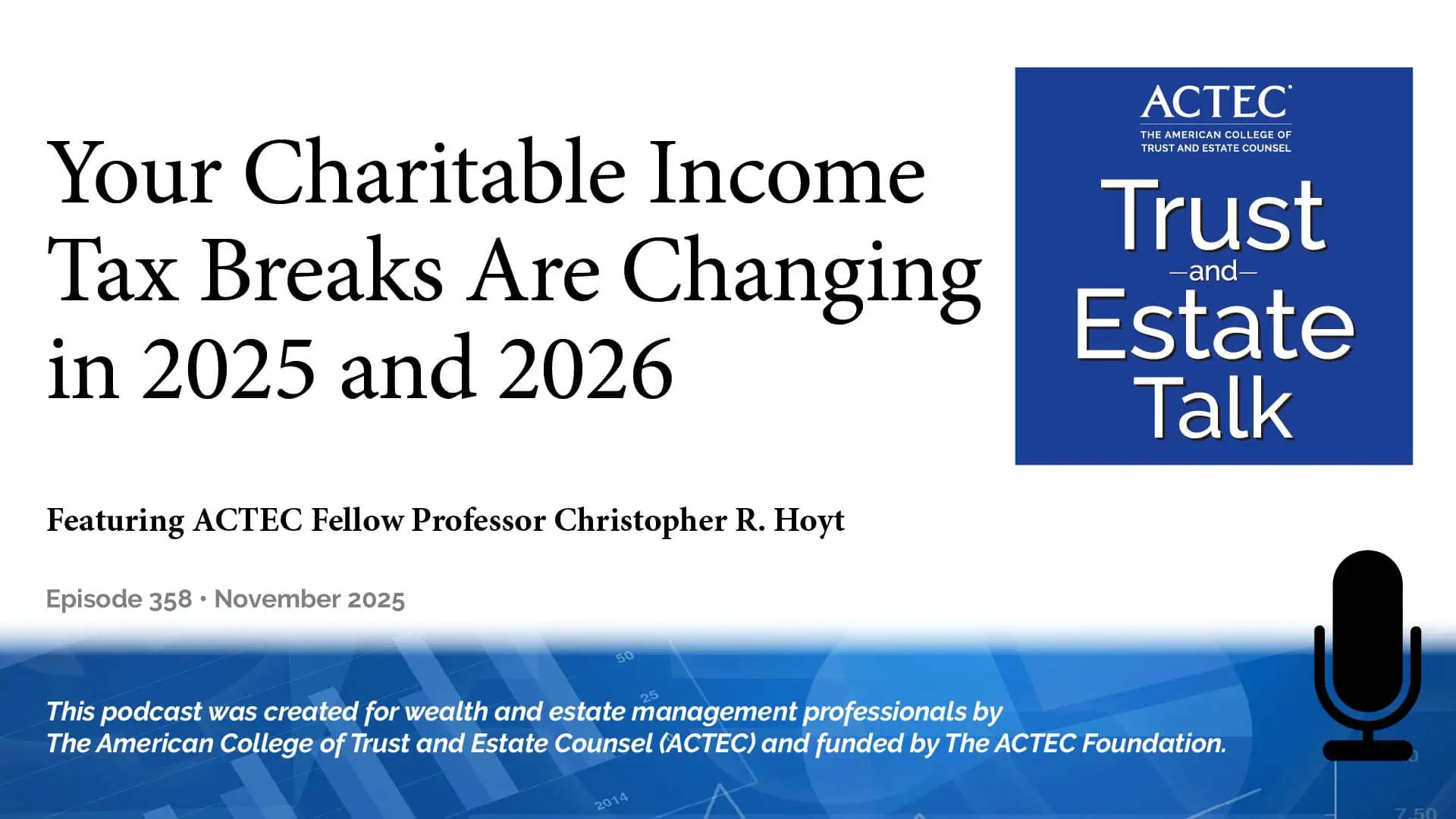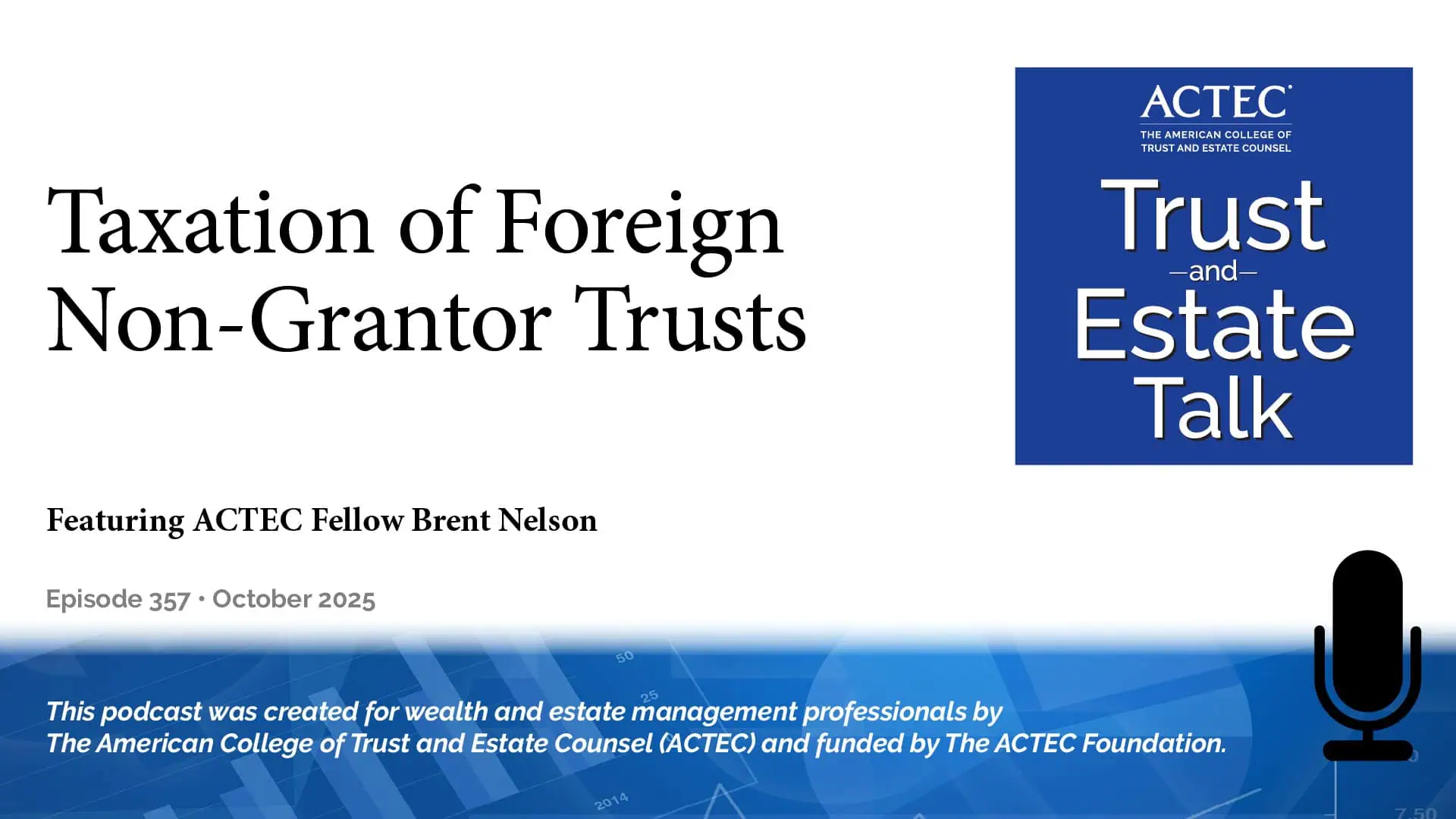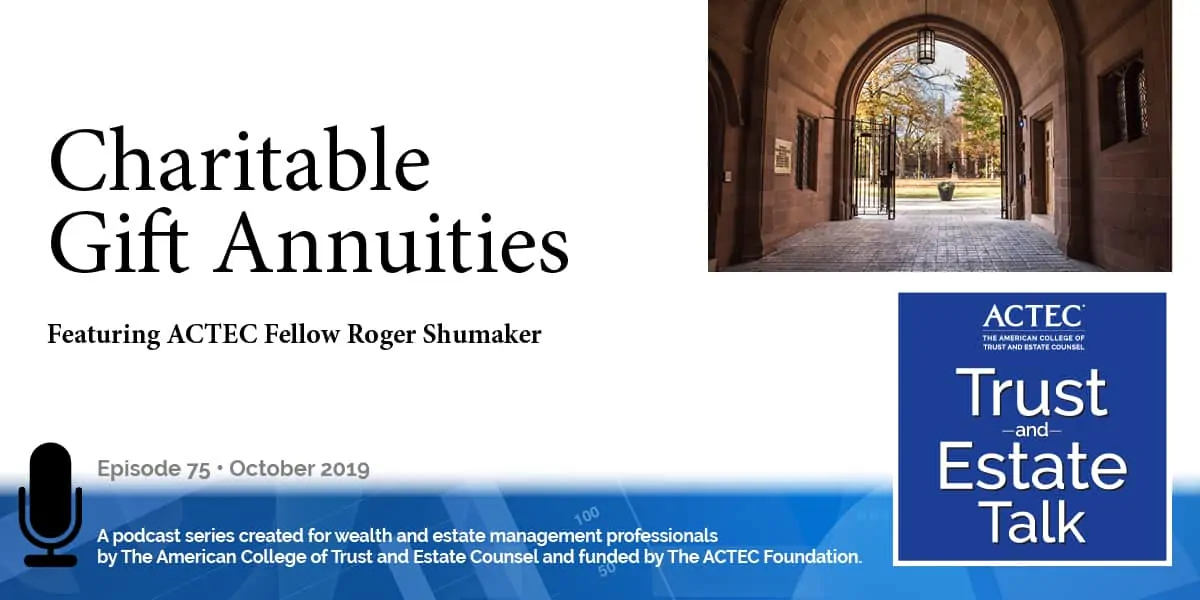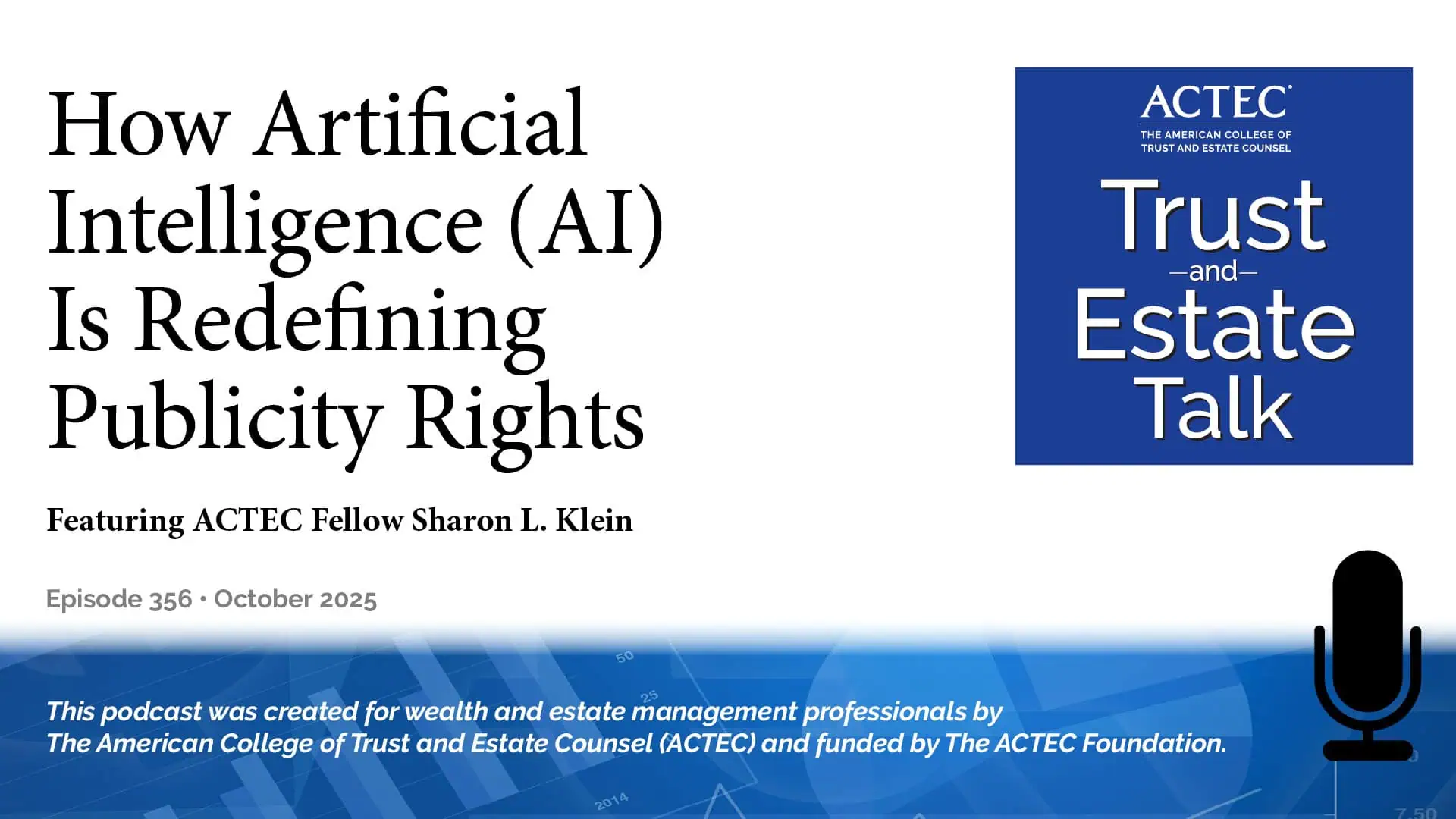Charitable Gift Annuities
“Charitable Gift Annuities,” that’s the subject of today’s ACTEC Trust and Estate Talk.
Transcript/Show Notes
This is Susan Snyder, ACTEC Fellow from Chicago. There are many different ways that individuals can benefit charity during lifetime. One charitable giving tool is the Charitable Gift Annuity. To learn more about this topic, I will be talking today with Roger Shumaker, ACTEC fellow from Cleveland. Welcome Roger.
Thank you, Susan. Well, a Charitable Gift Annuity is one of several charitable split interest planning tools that qualify for the charitable income tax deduction and for charitable transfer tax deductions. While charitable plan giving certainly preceded the 1969 Tax Act, something that happened before I started in my practice, the Charitable Gift Annuity along with other charitable split interest gifts like Charitable Remainder Trusts and Charitable Lead Trusts were officially sanctioned by that law.
The 1969 Act created the legal framework within which gifts that are not 100 percent to charity, but instead in part to charity and in part to individuals, can still qualify for favorable tax treatment. The Charitable Gift Annuity is a simpler version that is similar to the more familiar Charitable Remainder Trust – a gift to charity with a retain right to receive payments for life.
A Charitable Gift Annuity involves a contract between a charity and the donor in a traditional annuity contract format. The charity takes the role of the insurance company and the donor as the purchaser and the donor or another person as the annuitant entitled to receive the annuity payments. If the donor designates another person who is not the spouse of the donor as the annuitant, the tax results will be different than when the donor and/or the spouse are the annuitants under the contract.
In its simplest form, the donor enters into a signed agreement with a charitable organization, which in return for the payment to the charity, sometimes referred to as the purchase price, the donor is assured of an annuity payment to the annuitant for life. The charity must be a qualified charity for federal income tax purposes. As you might expect, because this is not a 100 percent gift in the sense that the annuitant has an interest in the property donated, the charitable deduction is not 100 percent. The Internal Revenue Code and regulations establish the proper valuation procedures for the charitable income tax deduction. The deduction is determined by valuing the annuity interest using normal valuation procedures always affected by the 7520 rate that applies at the time of the gift.
The donor will receive an income tax deduction equal to the difference between the fair market value of the donated property and the present value of the annuity. It’s the old familiar subtraction method that applies with Grantor Retained Annuity Trusts and other similar planning strategies.
Among the variations that add flexibility in exchange for complexity are: the donor can designate his or her spouse as a joint life recipient; the donor can designate someone other than the spouse as a direct annuitant or as a surviving annuitant; the donor can use appreciated securities instead of cash and the donor can defer the starting date of the annuity payments.
Let’s review some of the implications of these variations. Generally, for income tax purposes, each payment will be divided into an ordinary income portion, a capital gain portion if appreciated property is donated, and a portion that is not taxed as it represents a return of capital. The donor is allowed to receive, income tax-free, his or her investment in the contract over the expected term of the annuity. After the annuitant has received the investment in the contract, which will generally occur if the annuitant lives past his or her life expectancy, succeeding payments are treated entirely as ordinary income. If the donor is the annuitant or the joint donors or spouses are the annuitants, this general rule applies.
However, if the annuitant and donor are different persons, the general rule does not apply and the donor must report any capital gain immediately. The code and regulations treat it as a sale and then a purchase, so the capital gain is determined and reported then. In either case, the annuitant’s investment in the contract will generally be the present value of the annuity.
If the annuity payments are deferred beyond one year, the general rules also apply but the present value will be different because of the deferred starting date. While the calculation of the charitable deduction is essentially the same, based on the difference between the fair market value of the property transferred to charity and the present value of the annuity, the present value of the deferred annuity would be less and thus, the charitable deduction would be greater. If there is no fixed annuity starting date, the donor’s deduction will be based on the maximum possible present value of the annuity and therefore, the minimum charitable deduction.
For transfer tax purposes, the charitable portion should be reported as a gift, with an offsetting charitable deduction. The donor’s retained annuity is not a gift. If the spouse is the annuitant, that portion qualifies for the marital deduction. With a joint-life annuity, if one of the annuitants dies the interest of the surviving spouse qualifies for the marital deduction and the balance qualifies for the charitable deduction.
If someone other than the donor or the spouse is the annuitant, the value of the annuity is an immediate taxable gift that qualifies for the annual exclusion if the interest is immediate, but does not qualify for the annual exclusion if the annuity follows that of a prior annuitant or if the starting date is deferred.
There are a number of reasons that a Charitable Gift Annuity would be of interest to a donor. Generally, the annuity rate is higher than current investment returns. When investment returns are fairly low, as has been the experience for the past several years, some donors will look at the Charitable Gift Annuity as a good way to increase cash flow. The annuity rate offered by a charity is typically based on published rates from the American Council on Gift Annuities, an organization of charities that are interested in ensuring consistent opportunities for charities to offer the Charitable Gift Annuity.
At the same time, these published rates minimize the potential for charities to compete for gifts by offering higher payment rates. Nevertheless, some charities may offer higher or lower annuity rates in special circumstances. It’s important to note that the recommended rates are set to ensure approximately a 50 percent balance payable to the charity, if the annuitant lives to their actuarial life expectancy. Of course, if the annuitant lives beyond life expectancy, the charity will receive a smaller benefit. If the annuitant dies prior to their life expectancy, the charity will benefit because unfettered control of the funds is earlier and more of the contribution will remain. In either case, this does not affect the upfront deduction that is available when you make a Charitable Gift Annuity purchase.
Some smaller charities find the Charitable Gift Annuity to be an appealing opportunity. However, the actuarial risk can be great if the pool of annuitants is relatively small and too many of the annuitants live beyond the actuarial life expectancy. In that case, the anticipated benefit of the Charitable Gift Annuity program could disappear.
Here are a couple of examples from the current rate tables. A person who is aged 70 would receive a 5.6 percent annuity. At age 80, the annuity rate would be 7.3 percent. From an economic standpoint, the donor annuitant needs to understand that they are receiving some of their property back as part of each annuity payment.
Another reason — the donor wants to make a donation that is not large enough to warrant the use of a Charitable Remainder Trust. I have, over the years, advised clients in Charitable Gift Annuities, usually when the client is considering the first one. Reviewing a one or two page Charitable Gift Annuity agreement doesn’t require much time. After that there is little need for legal assistance on subsequent Charitable Gift Annuities. I find at the death of clients, they may have four or five annuities, Charitable Gift Annuities with various charities. It’s that easy.
For larger contributions where a Charitable Remainder Trust is advisable, the costs are obviously higher due to the drafting of the trust and trust administration costs. With the Charitable Gift Annuity, the charity does all the accounting and tax reporting as to the amounts includable by the annuitant on their return unlike the more cumbersome record keeping and tax reporting requirements of Charitable Remainder Trusts. The results of the benefit of a Charitable Gift Annuity are in this sense similar to the Charitable Remainder Trust, but when people are not making really big gifts the Charitable Gift Annuity offers a great opportunity.
When a donor wants to benefit someone other than the donor or the spouse of the donor, the donor can provide a fixed cash flow for the annuitant. Sometimes this is an attractive way to provide cash flow for a family member, for a friend or for a loyal employee. We have had clients do the latter in a number of cases.
There is one significant risk to the donor annuitant in that the annuity payments are an unsecured promise of the charity to pay, backed up by the assets of the charity. If the charity fails, the annuity payments will cease, with no recourse other than as a general creditor of the charity. With a Charitable Remainder Trust, even if the intended charities fail, the funds held by the trustee would remain intact and payments to the beneficiaries would be continued. And in most cases, the Charitable Remainder Trust will allow the trustee to select alternative qualified remainder beneficiaries.
There is also less flexibility in terms of benefiting multiple charities under one Charitable Gift Annuity contract. Charity A would love to have the remainder interest for their benefit; they are not likely to want to share that with another charity. The solution is to establish a Charitable Gift Annuity with each charity to be benefited. Given the simplicity of the Charitable Gift Annuity, this should not be burdensome.
Here are a few other tidbits to keep in mind. If the donor dies prior to reaching his life expectancy, the donor’s estate is permitted an income tax deduction on the decedent’s final income tax return in the amount of the unrecovered investment in the contract. If a donor other than an annuitant dies, the deduction is reportable by the annuitant on the final income tax return of the annuitant. The charity should be able to determine the amount of the deduction.
I have had this come up a number of times and it is very typical that the charity, if they’re a larger charity, will provide that information, but if you see a Charitable Gift Annuity during estate administration, you will want to be sure to check that on the unrecovered investment in the contract.
Some people with encumbered property may be frustrated when they realize they can’t make that contribution of property to a Charitable Remainder Trust. That rule does not apply to a Charitable Gift Annuity. Instead, the net value of the property after reduction for the amount of the debt will be used to determine the amount of the annuity and the donor’s deduction. However, it should be noted that any capital gain attributable to the debt would be reported immediately.
Here is another one. If there’s a completed gift to a non-donor annuitant, who is a skip person, generally the person more than one generation younger than the donor, the value of the interest transferred to that person would be subject to the Generation Skipping Transfer Tax. To the extent that the annual exclusion is not available for a generation skipping transfer, the donor would need to allocate the Generation Skipping Transfer Tax exemption to the value of the gift. This is not likely to come up because even a very elderly individual wanting the benefit of a grandchild might find that the annuity rate would be unattractive, although it would be a way to provide a fixed income to that beneficiary.
There are a lot of resources available on Charitable Gift Annuities; the American Council on Gift Annuities, the Planned Giving Design Center, a book called Tools & Techniques of Charitable Planning from National Underwriter, the National Association of Charitable Gift Planners’ website and the Tax Economics of Charitable Giving — a well-known and renowned resource for charitable planning–and the Harvard Manual on the Tax Aspects of Charitable Giving.
So, in my view, the Charitable Gift Annuity is a great tool for anyone looking for a bit of cash flow and a charitable income tax deduction. Very simple, legally cost effective and a great way to benefit charities.
Thank you, Roger, for educating us on the benefits of charitable gift annuities for both charity and donors.
This podcast was produced by The American College of Trust and Estate Counsel, ACTEC. Listeners, including professionals, should under no circumstances rely upon this information as a substitute for their own research or for obtaining specific legal or tax advice from their own counsel. The material in this podcast is for information purposes only and is not intended to and should not be treated as legal advice or tax advice. The views expressed are those of speakers as of the date noted and not necessarily those of ACTEC or any speaker’s employer or firm. The information, opinions, and recommendations presented in this Podcast are for general information only and any reliance on the information provided in this Podcast is done at your own risk. The entire contents and design of this Podcast, are the property of ACTEC, or used by ACTEC with permission, and are protected under U.S. and international copyright and trademark laws. Except as otherwise provided herein, users of this Podcast may save and use information contained in the Podcast only for personal or other non-commercial, educational purposes. No other use, including, without limitation, reproduction, retransmission or editing, of this Podcast may be made without the prior written permission of The American College of Trust and Estate Counsel.
If you have ideas for a future ACTEC Trust & Estate Talk topic, please contact us at ACTECpodcast@ACTEC.org.
Latest ACTEC Trust and Estate Talk Podcasts

A Trustee’s Perspective on Trust-Owned Life Insurance
Learn key considerations for trustees managing Irrevocable Life Insurance Trusts (ILITs) and how to navigate grantor rules and withdrawal rights.

Your Charitable Income Tax Breaks Are Changing in 2025 and 2026
Learn how 2025–2026 tax changes impact charitable deductions, DAFs, and SALT limits, plus smart year-end giving and IRA gift strategies.

Taxation of Foreign Non-Grantor Trusts
Learn how U.S. tax rules affect foreign non-grantor trusts and discover key strategies for cross-border estate planning and compliance.



